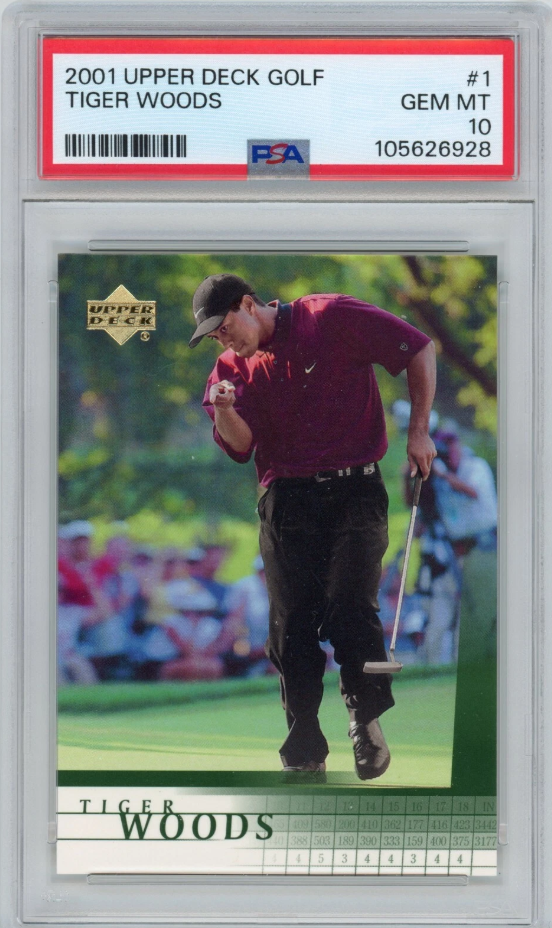In the ever-evolving world of sports collectibles, where cardboard and nostalgia intertwine, the 2001 Upper Deck Tiger Woods rookie card stands as a beacon of elegance and historical significance. Its appeal goes beyond the intricacies of cardboard nuances and speaks directly to the hearts of those who witnessed Tiger’s meteoric rise in the realms of professional golf. This isn’t just a rookie card; it’s a vivid snapshot of Tiger at the apex of his early career—a moment that changed the landscape of golf itself.
Picture this: it’s the early 2000s, and golf is no longer the leisurely sport some imagined it to be. It is the lifeblood of sports pages worldwide, and Tiger Woods is the dynamo at its heart, electrifying audiences globally. Upper Deck, with an astute sense of timing and an eye for iconic imagery, places Tiger’s visage on card number 1—the ultimate accolade for a year he indisputably dominated. The card itself, a marvel of simplicity, is an instant connection to that golden era of golf where Tiger ruled with an iron fist and a gentle smile.
For many collectors, the 2001 Upper Deck Tiger Woods rookie card is not just a piece of memorabilia; it’s a blueprint for blue chip collectibles in the golf domain. It’s findable enough to keep collectors hopeful, yet rare enough to ensure that pristine copies never idle for long in the marketplace. Its value remains robust in the financial playground of sports collectibles, with PSA 10 graded examples consistently fetching between $300 and $350. This steady valuation, juxtaposed across public logs and eBay sales, draws a definitive line in the sands where collectors negotiate.
But not all evidence is anecdotal. Data aficionados can turn to Card Ladder for confirmation, where the PSA 10’s trajectory remains predictably median, yet fluid enough to reward those with an eye for timing and aesthetics. The card’s staying power can be traced back to its foundational simplicity: no flashy parallels or obscure promotional gimmicks. It is simply the debut card of a legend—a straightforward tale that even those out of the collecting loop can appreciate.
The card’s liquidity—a trait as crucial as its aesthetic value—stems from a healthy circulation of graded copies, ensuring both short-term accessibility and long-term relevance. It is the subtle nuances, such as centering, edge sharpness, and surface clarity, that distinguish the mint from the near.
The design of the card itself has aged like fine wine. The photography captures an understated elegance, letting the viewer’s eye settle comfortably within its bordered confines. The card back avoids the clutter of banal statistics, providing instead a neat personal narrative—a trait not often seen in the chaotic mishmash that can be sports card statistics today. It fits seamlessly into a collection, whether standing beside a Jordan insert or a Brady rookie, it holds its own.
From the vantage point of design, history, and desirability, different collectors gravitate towards this card for varying reasons. For those enamored with the arc of golf card history, this represents a revival brought on by a major player in the card industry. For another sect, it’s the cleanest path to owning an iconic, graded rookie without falling into the costly abyss of parallel collections. For pragmatic investors, its consistent comp history instills a sense of confidence. This is often the sole golf card even non-golf enthusiasts keep, for it encapsulates an era succinctly and stylishly within its sturdy slab confines.
For the budding investor eying a PSA 10, preparation starts by honing in on evening eBay auctions, where the freshest values reveal themselves. Expect the transactions to settle in the $300 to $350 territory, with variance during quieter nights. If working towards a PSA 9 or encountering raw copies, scrutinize the corners, the edges—those collector-tested barometers of quality that can shift a valuation north or south. Here, patience is not just a virtue; it is a tangible statistic.
The thrill of discovery isn’t solely reserved for those attending auctions. Rip packs, the modern-day treasure chests for card enthusiasts, might just yield a 2001 Upper Deck Tiger Woods from their curated contents. Concealed within Silver, Gold, or Platinum Galaxy Rip Packs, this card transforms a mere pack-opening into a potential legend-creating moment—an experience that mirrors adding Tiger’s rookie to a prized collection.
Ultimately, the 2001 Upper Deck Tiger Woods rookie card is more than cardboard; it’s a bridge between nostalgia and contemporary demand. It speaks to moments when Tiger turned the simplest Sunday into a spectacle and finds its rightful place in modern collections where stats and stories coexist digitally. Its price history remains steady, an indicator of its timeless allure—an enduring tribute to the profound impact one athlete had on golf and the world of sports collectibles. As you pull this card from a protective case, it’s more than an ownership claim; it’s an invitation to reminisce about an era when Tiger’s shadow loomed large over greens worldwide.

